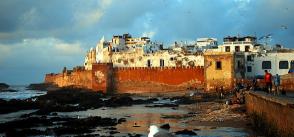
Inside Morocco's renewable revolution
In taking on the role of a green leader among developing nations, Morocco struggles to balance its investment in the future with the needs of today.
On a recent morning in the mountains above this thriving port city, the wind turbines are quiet and still. Occasionally a slight breeze catches a propeller, spinning it ever so slowly and filtering the harsh sun in a dance of rays on the brown earth. It is not a good day for wind, but it is a good day for Essedik Chellouch, who is patrolling the Dhar Saadane wind farm with his dog, Weeza.
Mr. Chellouch, who lives in a nearby village, was on a local work crew that helped build the Dhar Saadane project. When it opened in 2009, bringing 126 turbines online to produce electricity, Chellouch was hired as a security guard. With his minimum wage earnings, about $230 a month, he was able to buy a house.
And while the men gathered outside the mosque in his village grumbled about what the Tangier wind farm, which includes Dhar Saadane and another nearby location with 39 turbines, has or hasn’t done for the local economy, Chellouch has made a living from Africa’s largest wind farm, part of Morocco’s extraordinary effort to fight climate change and produce its own renewable energy.
“It’s been good,” Chellouch says. “People have been able to make their life.”
Morocco has become a green leader among developing nations, with an ambitious goal to produce more than half of its own energy needs by 2030 through a growing network of more than 50 public and private solar, wind, and water projects. The push is part of a national effort to curb greenhouse gas emissions, reduce pollution, and boost Morocco’s energy independence. For many Moroccans, the transition represents a necessary investment in the future. But for others, especially members of the poor and working class, that down payment on a new economy doesn’t visibly help meet their basic daily needs today.
Read the full article by Jackie Spinner via CS Monitor.
[Photo by Davidlohr Bueso | Flickr]







